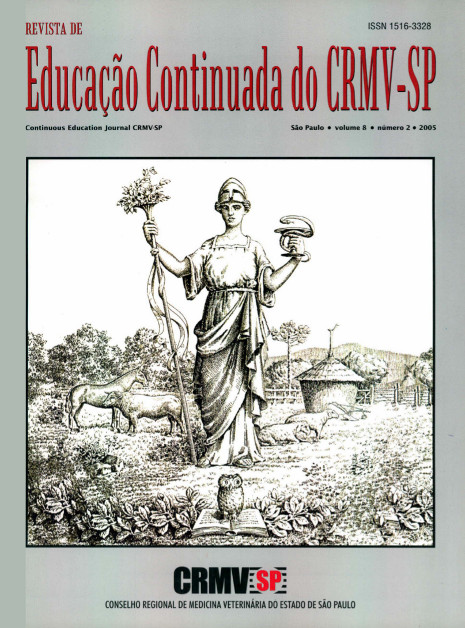Avaliação anatômica da secção da área transversal dos tendões da região distal dos membros torácicos de asininos (Equus asinus) utilizados como veículo de tração animal
Conteúdo do artigo principal
Resumo
Objetivo: Realizar um estudo anatômico e radiográfico da secção da área transversal dos principais tendões que compõe a região distal dos membros torácicos. Assim, buscam-se subsídios à prática clínica e cirúrgica dedicada a esses animais, bem como a compreensão de sua maior resistência a lesões locomotoras, quando comparados ao eqüino. Material e Método: Foram analisados os membros torácicos de 15 asininos, de diferentes sexos e idades. Os animais pesavam em média 150 kg, eram alimentados com ração volumosa e utilizados em veículos de tração animal. Após a retirada dos membros, foram realizadas radiografias, em projeção lateromedial. Posteriormente, as peças foram fixada em solução de formalina a 10% e submetidas à dissecação que individualizou os tendões da região estudada. Com um paquímetro de precisão 0,05 mm, foi realizada a mensuração dos tendões do músculo flexor digital superficial, músculo flexor digital profundo e tendão interósseo médio, aferindo-se a largura e espessura desses tendões em sete zonas predefinidas. Resultados e Conclusões: Os maiores valores de secções transversais para o tendão flexor digital superficial, profundo e interósseo mostraram coincidência com os pontos de maior estresse articular. Foram observados também valores de secção de área transversal que excediam aqueles verificados para a média da população, fato devido a processos inflamatórios tendíneos crônicos decorridos do exaustivo trabalho executado por esses animais. Desse modo, caracterizou-se a grande especialização locomotora a essas atividades, bem como a resistência dos asininos a lesões nessas estruturas do seu aparelho locomotor.
Detalhes do artigo
Edição
Seção
1. Autores mantém os direitos autorais e concedem à revista o direito de primeira publicação, com o trabalho licenciado sob a Creative Commons Atribuição-NãoComercial-SemDerivações 4.0 Internacional
2. Autores têm autorização para assumir contratos adicionais separadamente, para distribuição não-exclusica da versão do trabalho publicada nesta revista (ex.: publicar em repositório institucional ou como capítulo de livro), com reconhecimento de autoria e publicação inicial nesta revista.
3. Autores têm permissão e são estimulados a publicar e distribuir seu trabalho online (ex.: em repositórios instituicionais ou na sua página pessoal) a qualquer ponto antes ou durante o processo editorial, já que isso pode gerar alterações produtivas, bem como aumentar o impacto e a citação do trabalho publicado (Veja O Efeito do Acesso Livre);
